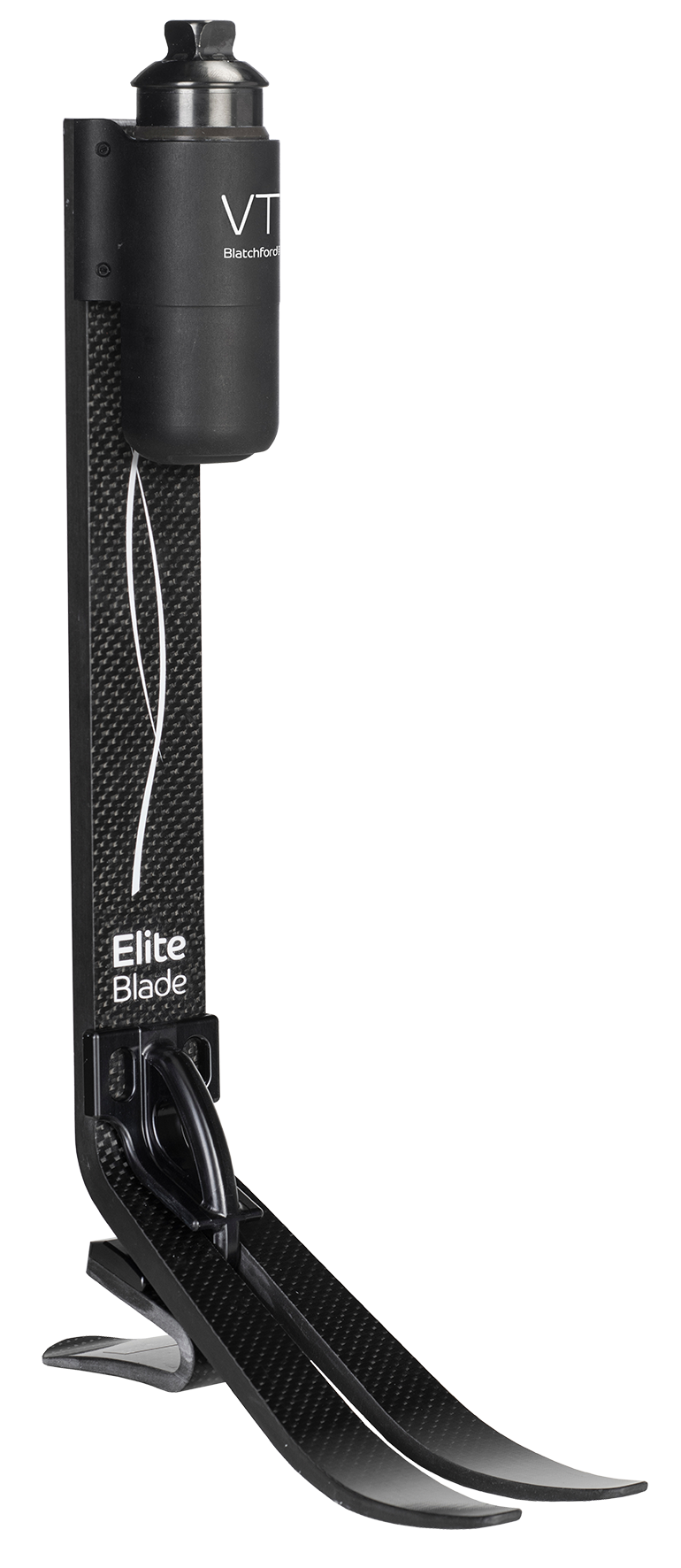Elite BladeVT
The Elite BladeVT prosthetic running foot offers stellar performance for high impact, Level 3-4, activities and sports. The blade flexibility combined with the shock absorber and rotation device enhance power, speed, agility and comfort.
The technology incorporates the proven endolite e-carbon tripod footspring design with an innovative and highly durable titanium axial spring which makes twisting and turning in the office, on the court or in the park with the kids, a smooth and comfortable experience, reducing stress on the back and other joints.
- Activity level 3
- Activity level 4
- Suitable for outdoor use
Elite BladeVT Clinical Evidence Reference
Clinical Outcomes using e-carbon feet
-
Safety
- High mean radius of curvature for Esprit-style e-carbon feet2: “The larger the radius of curvature, the more stable is the foot”
-
Mobility
- Allow variable running speeds3
- Increased self-selected walking speed4
- Elite-style e-carbon feet (L code VL5987) or VT units demonstrate the second highest mobility levels, behind only microprocessor feet5
-
Loading symmetry
- Users demonstrate confidence in prosthetic loading during high activity6
- Improved prosthetic push-off work compared to SACH feet7
- Increased prosthetic positive work done4
-
User satisfaction
- High degree of user satisfaction, particularly with high activity users8
Improvements in Clinical Outcomes using shock-absorbing pylon/torque absorber compared to rigid pylon
-
Safety
- Reduced back pain during twisting movements e.g. golf swings9
-
Mobility
- Reduced compensatory knee flexion at loading response10
- No reduction in step activity11
- Blatchford torsion adaptors match the able-bodied rotational range12
-
Residual Limb Health
- Reduced loading rate on prosthetic limb13, particularly at fast walking speeds14
- Users feel less pressure on their residual limb15
-
User Satisfaction
- Patient preference, citing improved comfort, smoothness of gait and easier stairs descent13
References
-
Full Reference Listing
-
Crimin A, McGarry A, Harris EJ, et al.
The effect that energy storage and return feet have on the propulsion of the body: A pilot study. Proc Inst Mech Eng [H] 2014; 228: 908–915.
-
Curtze C, Hof AL, van Keeken HG, et al.
Comparative roll-over analysis of prosthetic feet. J Biomech 2009; 42: 1746–1753.
-
Strike SC, Arcone D, Orendurff M.
Running at submaximal speeds, the role of the intact and prosthetic limbs for trans-tibial amputees. Gait Posture 2018; 62: 327–332.
-
Ray SF, Wurdeman SR, Takahashi KZ.
Prosthetic energy return during walking increases after 3 weeks of adaptation to a new device. J Neuroengineering Rehabil 2018; 15: 6.
-
Wurdeman SR, Stevens PM, Campbell JH.
Mobility analysis of AmpuTees (MAAT 5): Impact of five common prosthetic ankle-foot categories for individuals with diabetic/dysvascular amputation. J Rehabil Assist Technol Eng 2019; 6: 2055668318820784.
-
Haber CK, Ritchie LJ, Strike SC.
Dynamic elastic response prostheses alter approach angles and ground reaction forces but not leg stiffness during a start-stop task. Hum Mov Sci 2018; 58: 337–346.
-
Rock CG, Wurdeman SR, Stergiou N, Takahashi KZ.
Stride-to-stride fluctuations in transtibial amputees are not affected by changes in push-off mechanics from using different prostheses. PloS one. 2018;13(10).
-
Highsmith MJ, Kahle JT, Miro RM, et al.
Differences in Military Obstacle Course Performance Between Three Energy-Storing and Shock-Adapting Prosthetic Feet in High-Functioning Transtibial Amputees: A Double-Blind, Randomized Control Trial. Mil Med 2016; 181: 45–54.
-
Rogers JP, Strike SC, Wallace ES.
The effect of prosthetic torsional stiffness on the golf swing kinematics of a left and a right-sided trans-tibial amputee. Prosthet Orthot Int 2004; 28: 121–131.
-
Berge JS, Czerniecki JM, Klute GK.
Efficacy of shock-absorbing versus rigid pylons for impact reduction in transtibial amputees based on laboratory, field, and outcome metrics. J Rehabil Res Dev 2005; 42: 795.
-
Klute GK, Berge JS, Orendurff MS, et al.
Prosthetic intervention effects on activity of lower-extremity amputees. Arch Phys Med Rehabil 2006; 87: 717–722.
-
Flick KC, Orendurff MS, Berge JS, et al.
Comparison of human turning gait with the mechanical performance of lower limb prosthetic transverse rotation adapters. Prosthet Orthot Int 2005; 29: 73–81.
-
Gard SA, Konz RJ.
The effect of a shock-absorbing pylon on the gait of persons with unilateral transtibial amputation. J Rehabil Res Dev 2003; 40: 109–124.
-
Boutwell E, Stine R, Gard S.
Shock absorption during transtibial amputee gait: Does longitudinal prosthetic stiffness play a role? Prosthet Orthot Int 2017; 41: 178–185.
-
Adderson JA, Parker KE, Macleod DA, et al.
Effect of a shock-absorbing pylon on transmission of heel strike forces during the gait of people with unilateral trans-tibial amputations: a pilot study. Prosthet Orthot Int 2007; 31: 384–393.
-



